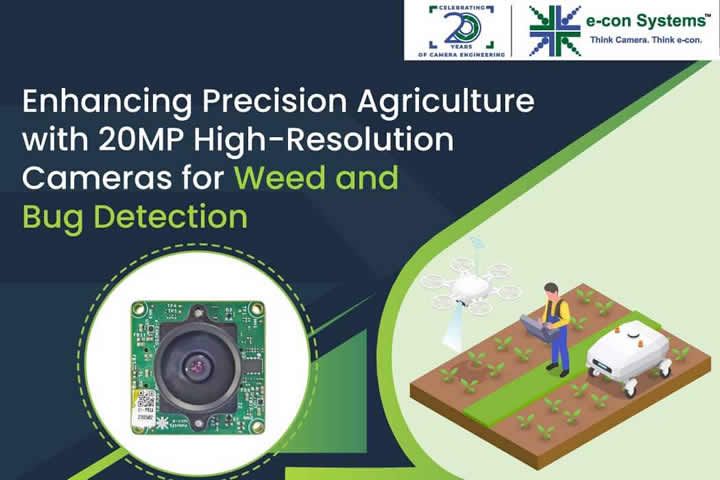In this blog, we explore how a 20MP high-resolution AR2020 sensor-powered camera and its functionality help enhance precision agriculture techniques such as weed and bug detection methods.
Gomathi Sankar | e-con Systems
Precision agriculture has increasingly turned towards embedded vision systems for accelerating and improving farming practices. This can be evidenced by the role of imaging technology in the detection of weeds and bugs, which are critical components of crop management. Designed to replicate human visual perception, these systems identify and differentiate between crops, weeds, and pests. This capability empowers the targeted application of herbicides and pesticides while optimizing resource usage and minimizing environmental impact.
In this blog, we’ll look at why weed and bug detection are critical in precision agriculture and how AR2020 sensor-powered camera solutions play a major role in the overall process.
Why ineffective weed and bug detection can be deadly
- Results in poor crop yields due to competition from weeds and damage from pests
- Causes an increased usage of herbicides and pesticides, triggering environmental degradation and potential health risks for consumers
- Increases labor and resource costs, impacting the profitability of farming operations.
Role of AR2020 sensor-based cameras for weed and bug detection
The AR2020 sensor is a part of onsemi’s Hyperlux LP product family. It is a 1/1.8-inch stacked CMOS digital image sensor with a 5120 x 3840 active-pixel array. The sensor is equipped with a 1.4 μm BSI pixel from onsemi, optimized for outstanding performance in low-light and Near-Infrared (NIR) wavelengths. It is a high-quality, low-power consumption device, making it an ideal choice for data capturing at the edge of smart agriculture. Some of its unique features for weed and bug detection include:
High resolution
AR2020 sensor-based cameras can be tremendously effective for critical monitoring tasks that require high resolution images. For example, it allows for detailed imaging while monitoring leaf edges for bug bites. This enables the detection of minute changes in leaf structure and coloration, which are indicative of insect activity. So, it becomes easy to detect pest infestation, allowing for timely intervention and minimizing crop damage. Also, the high resolution improves weed detection by making it possible to differentiate between crop plants and weeds based on their NIR light reflection patterns.
Enhanced Dynamic Range (eDR)
This feature broadens the range of light intensities it can capture, from the brightest to the darkest. Why is this crucial? In agriculture, lighting conditions can vary dramatically, from direct sunlight to shadows under foliage. The eDR guarantees that details are not lost in such high-contrast scenarios, enabling more accurate detection and classification of weeds, pests, and diseases in crops. This feature also helps deliver consistent image quality throughout the day as sunlight intensity and angles change.
Enhanced NIR response
AR2020 sensor’s enhanced Near-Infrared (NIR) response is a game-changer for weed and bud detection applications. This feature boosts the sensor’s ability to capture images in the NIR spectrum, which is beyond the visible range for humans. This characteristic is leveraged to distinguish between healthy crops and unwanted weeds or pests.
For instance, enhanced NIR enables Normalized Difference Vegetation Index (NDVI) measurement, which assesses vegetation health by identifying plant vigor, chlorophyll concentration, etc. It calculates the difference between NIR light, which healthy vegetation strongly reflects, and visible light, which healthy vegetation absorbs. Other crop analyses it aids include Soil Adjusted Vegetation Index (SAVI), Leaf Area Index (LAI), etc.
Multiple functional modes
 Global Reset Release (GRR): This mode ensures uniform exposure across the entire pixel array for accurately identifying and classifying different plant species and pests. It eliminates the distortion often caused by partial exposure in traditional sensors.
Global Reset Release (GRR): This mode ensures uniform exposure across the entire pixel array for accurately identifying and classifying different plant species and pests. It eliminates the distortion often caused by partial exposure in traditional sensors.
Trigger mode: This mode improves the sensor’s adaptability in dynamic environments, such as changing weather conditions or varying light levels throughout the day. It is extremely useful in time-critical applications, like monitoring the rapid spread of pests or diseases in crops.
Context switching: It allows for seamless transition between different imaging modes, adapting to the changing requirements of precision agriculture. This adaptability is crucial for managing the detection of weeds and bugs in different crop types and stages of growth. Moreover, the ability to switch contexts quickly minimizes downtime and maximizes monitoring performance across large areas.
e-con Systems’ latest AR2020 sensor-based camera for weed and bug detection
e-con Systems, with 20+ years of experience in designing, developing, and manufacturing OEM cameras, has been helping modernize traditional agricultural practices with precision imaging solutions.
e-CAM200_CUMI2020C_MOD is our recently-launched 20MP camera that features the advanced AR2020 sensor, developed for high-resolution imaging in applications such as detecting weeds and bugs. This camera excels in low-light conditions, benefiting from e-con Systems’ extensive experience in Image Signal Processing (ISP) to provide outstanding image quality.
Please explore our Camera Selector Page to locate the best-fit camera based on your application’s unique use case demands.
You can also browse our Autonomous Agriculture & Smart Farming Page, which showcases the length and breadth of our expertise.
If you need expert help in integrating the ideal camera solution into any of your precision agriculture applications, please write to us at camerasolutions@e-consystems.com.
Gomathi Sankar is a camera expert with 15+ years of experience in embedded product design, camera solutioning, and product development. In e-con Systems, he has built numerous camera solutions for robots, industrial handhelds, quality inspection systems, smart city applications, industrial safety systems, and more. He has played an integral part in helping hundreds of customers build their dream products by integrating the right vision technology into them.
The content & opinions in this article are the author’s and do not necessarily represent the views of AgriTechTomorrow
Comments (0)
This post does not have any comments. Be the first to leave a comment below.
Featured Product



